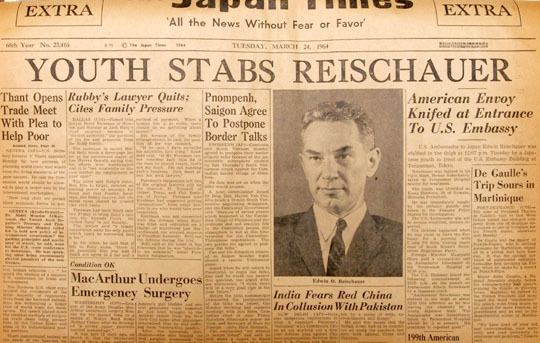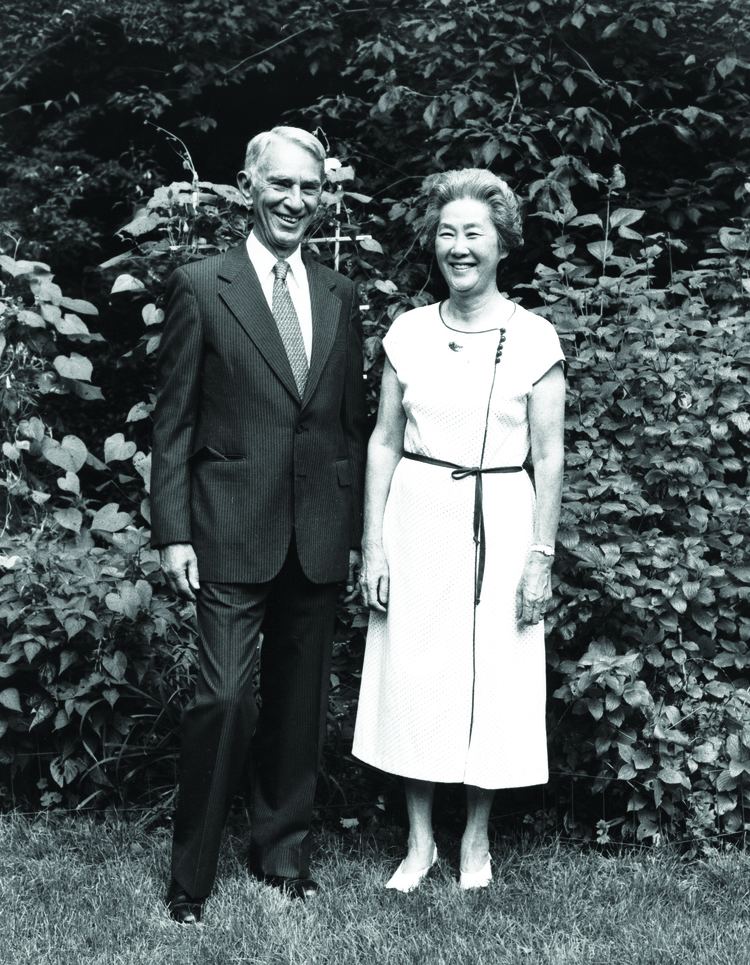Other names エドウィン・O・ライシャワー Children Robert Reischauer Role Educator | Name Edwin Reischauer Nationality American | |
 | ||
Fields JapanologyEast Asian studies Died September 1, 1990, La Jolla, San Diego, California, United States Spouse Haru M. Reischauer (m. 1956–1990), Elinor Adrienne Danton (m. 1935–1956) Books The Japanese today, Japan; the story of a nation, Japan - tradition & transformation, China: Tradition & Transformation, The United States and Japan Similar People Albert M Craig, Robert Reischauer, Serge Elisseeff, Dean Rusk | ||
2013 edwin o reischauer lectures q a 3 toward an archaeology of distraction
Edwin Oldfather Reischauer (October 15, 1910 – September 1, 1990) was an American educator and professor at Harvard University. He was a leading scholar of the history and culture of Japan and East Asia. A former student, James C. Thomson, Jr., brought his name to the attention of Chester Bowles, the new Under Secretary of State for newly elected John F. Kennedy. Kennedy appointed him as the United States Ambassador to Japan (1961–1966).
Contents
- 2013 edwin o reischauer lectures q a 3 toward an archaeology of distraction
- 2014 edwin o reischauer lectures 2 east asian internationalism and beyond
- Early life and education
- Teaching career
- Personal life
- Later life
- Romanization of Korean
- US policymaker
- World War II and afterward
- Myth of saving Kyoto
- US bases in Okinawa
- Illness and death
- Honors
- Notable students
- References
2014 edwin o reischauer lectures 2 east asian internationalism and beyond
Early life and education

Reischauer was born in Tokyo, Japan, the son of Presbyterian educational missionaries Helen Sidwell Oldfather and August Karl Reischauer. He attended the American School in Japan and graduated with a B.A. from Oberlin in 1931. On his 75th birthday, he recalled publicly that his aim in life in 1931 was to draw attention to Asia.
He earned his Ph.D. from Harvard University in 1939. He was a student of the Russian-French Japanologist Serge Elisséeff, who had been the first Western graduate of the University of Tokyo. His doctoral dissertation was "Nittō guhō junrei gyōki: Ennin's Diary of His Travels in T'ang China, 838–847", a study and translation of the Japanese monk Ennin's travelogues on his journeys in China during the Tang dynasty. Ennin's work, Record of a Pilgrimage to China in Search of the Law (入唐求法巡礼行記; Middle Chinese: Nyip-Dang gjuw-pjop zwin-léi hæng-kì), is written in Classical Chinese, and Reischauer's work demonstrates the high level of Sinological scholarship that a student was expected to demonstrate.
Teaching career
His teaching career of 40 years was spent at Harvard, where he and John King Fairbank developed a popular undergraduate survey of East Asian history and culture. The course, which was known as "Rice Paddies," was the basis for their widely-influential two textbooks, East Asia: The Great Tradition (1958) and East Asia: The Modern Transformation (1965). Reischauer wrote both for fellow scholars and for the general public, including Japan: Story of a Nation, which appeared in several editions. He served as director of the Harvard–Yenching Institute and chairman of the Department of Far Eastern Languages. In a farewell lecture at the Yenching Institute in 1981, students had to compete for seats with faculty colleagues, university officials, and a television crew from Japan.
In that crowded scene, he said, "As I remember, there were only two graduate students interested in East Asian studies when I first came here: myself and my brother."
Personal life
On January 17, 1955, Reischauer's wife, (Elinor) Adrienne Danton Reischauer, died of a heart ailment. They had married in Tokyo on July 5, 1935. Thus, he was a widower with three children in August 1955 when author James A. Michener introduced him to Haru M. Reischauer at the Foreign Correspondents Club in Tokyo, who would become his second wife on January 16, 1956. It turned out that as teenagers, they had gone to the same Tokyo high school, where she had had a secret crush on him. Both became a formidable team. The Belmont, Massachusetts, house that they designed together is maintained and used today as the Edwin O. Reischauer Memorial House.
Later life
In 1973, he was the founding Director of the Japan Institute, which was renamed the Edwin O. Reischauer Institute of Japanese Studies in his honor when he turned 75, in 1985.
Reischauer was also honored in 1985 by the opening of the Edwin O. Reischauer Center for East Asian Studies at the Paul H. Nitze School of Advanced International Studies (SAIS), part of Johns Hopkins University. Speaking at the dedication ceremonies in Baltimore, Senator Jay Rockefeller, one of Reischauer's former students, described Reischauer as being "what a teacher is meant to be, one who can change the life of his students." At the same event, Japan's ambassador, Nabuo Matsunaga, read a personal message from Prime Minister Yasuhiro Nakasone: "I know of no other man who has so thoroughly understood Japan."
Romanization of Korean
With George M. McCune, Reischauer in 1939 published the McCune–Reischauer system for romanization of the Korean language, which became the most-widely used system for many years.
Reischauer called Hangul, the Korean alphabet, "perhaps the most scientific system of writing in general use in any language."
US policymaker
Reischauer promoted US foreign policy both in public and in government on Japan the rest of Asia after World War II and during the Vietnam War.
World War II and afterward
On September 14, 1942, three years before the end of World War II, Reischauer, then an instructor in Far Eastern languages at Harvard University, wrote the "Memorandum on Policy towards Japan." It laid out a plan on how the US could attain its postwar objective of "winning the peace" in Asia. According to Japanese historian Takashi Fujitani, the memo revealed a "condescension toward Japanese people" and a "purely instrumentalist and manipulative stance." In the abstract to his article, "The Reischauer Memo: Mr. Moto, Hirohito, and Japanese American Soldiers," Fujitani wrote:
Already at this early date in the war, Reischauer proposed retention of the Japanese emperor as head of a postwar “puppet regime” that would serve U.S. interests in East Asia. He also argued that Japanese Americans had until then been a “sheer liability” and that the United States could turn them into an “asset” by enlisting them in the U.S. military. He reasoned that Japanese American soldiers would be useful for propaganda purposes – that is, to demonstrate to the world and particularly the “yellow and brown peoples” that the United States was not a racist nation.
Myth of saving Kyoto
During the war, Reischauer was a Japan expert for the US Army Intelligence Service, and a myth developed after the war that he prevented the nuclear bombing of Kyoto. That tale was passed along by Robert Jungk, who claimed that Reischauer convinced his boss to persuade Secretary of War Henry L. Stimson not to bomb Kyoto and to have it crossed off the black list. Reischauer specifically denied that popular myth:
I probably would have done this if I had ever had the opportunity, but there is not a word of truth to it. As has been amply proved by my friend Otis Cary of Doshisha in Kyoto, the only person deserving credit for saving Kyoto from destruction is Henry L. Stimson, the Secretary of War at the time, who had known and admired Kyoto ever since his honeymoon there several decades earlier.
US bases in Okinawa
A "secret" memorandum, declassified in 1996, detailing the conversation among top US military and civilian officials on July 16, 1965 in Tokyo, revealed a plan put forward by Reischauer, then serving as the US Ambassador to Japan, to enable the US both to keep its military bases to introduce nuclear weapons in Okinawa after the reversion of the US-occupied islands to Japanese sovereignty. Reischauer based his strategy on the symbolic political importance of reversion for Japan's conservative ruling party but argued that the US did not have to "give Japan any real say in the use of our bases."
He said that "if Japan would accept nuclear weapons on Japanese soil, including Okinawa, and if it would provide us with assurances guaranteeing our military commanders effective control of the islands in time of military crisis, then we would be able to keep our bases on the islands, even though 'full sovereignty' reverted to Japan."
All that "became key elements [of] the 1969 U.S.-Japan Okinawa Reversion Agreement," effectively making "U.S. military presence more or less permanent and maintaining the option to introduce nuclear weapons." Reischauer himself confirmed that according to a 1981 article in Time:
Since the 1950s, Japan's Liberal Democratic government has solemnly and repeatedly affirmed three basic principles about nuclear weapons: not to make them, possess them or allow them into the country. In 1960, with the signing of the U.S.-Japan Security Treaty, Washington agreed not to "introduce" nuclear weapons into Japan. Two weeks ago, however, former U.S. Ambassador to Japan Edwin O. Reischauer revealed that the two countries have ever since been living a convenient lie. In an interview with Tokyo's Mainichi Shimbun, Reischauer asserted that U.S. naval vessels carrying nuclear weapons have routinely visited Japanese ports—with Tokyo's tacit approval.
The secret memo also revealed Reischauer's proposed countermeasures to quell "nationalistic reaction" to continuing US military presence in Okinawa. In his article, "'Secret' 1965 Memo Reveals Plans to Keep U.S. bases and Nuclear Weapons Options in Okinawa After Reversion," Steve Rabson, former US Army draftee in Okinawa in 1967 and 1968 and now author and lecturer on Okinawan literature, history, and culture, wrote:
To reduce the risk of “disturbances” in Okinawa, Reischauer proposed an increase in U.S. aid, revision of the Price Act to increase compensation for owners of land the U.S. had seized for base construction, and a loosening of the ban on flying the Japanese flag. It is difficult to measure precisely his influence at the time, but all three of these recommendations became U.S. policy.
Illness and death
In 1964, while serving as Ambassador to Japan, Reischauer was stabbed in an assassination attempt. His attacker was captured and deemed by authorities to be mentally disturbed. He apparently acted alone and had no connection to any group or cause. In the aftermath of the violence, Japan's Minister of Public Safety was compelled to resign.
Reischauer received a blood transfusion and recovered from his wound, but the transfusion infected him with hepatitis for the rest of his life. Although he continued to work and lead an active life, he eventually died from the complications of hepatitis.
